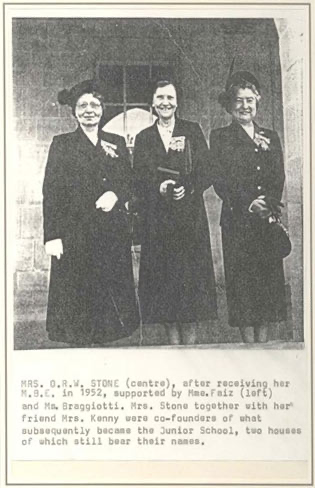The Very Beginning
Towards the end of 1943, still very much in the middle of the war, the evacuees, who had left Cyprus at the fall of Crete two and a half years before, began to drift back to the island. They were mostly English women and children and there was an immediate problem in that there were now no English language schools for the children to go to. The Minister of Education sent for Mrs Stone, who had a Mathematics degree from Cambridge, and Mrs Kenny, who had an English degree from Oxford, and simply said: “Start a school.”
So they did, in Mrs Stone’s house in Tennyson Street, with no books, no desks or blackboards. They had exercise books and pencils and a map of the world; and fifteen pupils straggling between the ages of five and fifteen! The staff – all two of them – taught everything from Reading and Writing to Games and the History of Art.

1952: Mrs Stone (centre)
The evacuees poured back to Nicosia and the school grew and grew till the hall and the dining room and the drawing room and even the spare bedrooms were being used for classes. They managed to acquire textbooks and vital equipment and – greatest relief of all – teachers! Now Mrs Stone and Mrs Kenny no longer had to spend their evenings studying the Geography of Japan or the Life of Neolithic Man in preparation for the next day’s lessons: they handed that sort of thing over to the experts. The school was now established, but the walls of Mrs Stone’s house were bulging, so the British Council took over. They bought a large house up on the hill, John Gayford came out from England as headmaster, and they called it The Junior School.
That small, hectic beginning is still remembered by some, though probably not many people know the origins of the names of the three houses: Kenny, Stone and Gayford.
By Mr. Patrick Bosustow (Headmaster 1957-1981)

